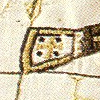Jerusalem Cross

(See also The rightful owners of Jerusalem)
Origins
The Jerusalem Cross is also known as the Crusader's Cross or Cantonee Cross.

Eustace, wearing odd coloured shoes and showing off the special French skill of riding on a horse backwards
(Click image to enlarge)
The earliest depiction we've seen of anything like the Jerusalem Cross is on the Bayeux Tapestry, a cartoon of the 1066 Norman invasion of England. The tapestry itself was probably completed in the 1070s, so we can be reasonably confident of the accuracy of many details.
(There is evidence, however, of a much earlier connection, which we comment on further down this page.)
One such detail is the banner carried by Count Eustace. This banner could have been the one given to him by Pope Alexander II to show the Church's support for the invasion of England.
This banner is interesting on two counts:
- Firstly, it appeared long before European heraldry became trendy in Europe.
- Secondly, Eustace had three sons. The first was also confusingly called Eustace, the next Godfrey, and finally Baldwin. Both Godfrey and Baldwin later became monarchs of Jerusalem. Godfrey was also Duke of Lower-Lorraine and his coat of arms included the Jerusalem Cross.

We have to admit that this evidence is insufficient proof of the cross' origin. The English copy of the tapestry just shows a golden cross with four black blobs, and the original tapestry, if they are indeed crosses (closer examination is currently pending), then cross-over stitching may have been just a convenient method to show circles, moons, hearts, or anything else. Nevertheless, the similarity to the Jerusalem Cross is striking.
Interpretations
The Jerusalem Cross represents Christ's command to spread the Gospel around the world; a mission that started in Jerusalem.
It's a busy collection of five crosses and the most common interpretations are:
- A combination of the Old Testament teachings (the four Tau Crosses) and the New Testament teachings (the four Greek Crosses)
- The four evangelists, Matthew, Mark, Luke and John, with Christ in the centre. (See Evangelists' Cross)
- Christianity (central cross) broadcast by missionaries to the four corners of the world
- Representative of the five wounds of Jesus on the cross; small crosses for the hands and feet pierced by the nails, and the large central cross for the spear wound in his side. The Crucifixion scene is played out annually in the Old City of Jerusalem. (See Stations of the Cross)
- And finally, as called by some Christians in Jerusalem, a Pilgrim's Cross; the large central cross representing the pilgrim, and the smaller crosses representing those who support and pray for the pilgrim during her or his pilgrimage. (See Wayside Cross, which is also sometimes referred to as 'Pilgrim Cross'.)
Yet another name is New Jerusalem Cross, focusing attention on the Divine and Heavenly restoration of Jerusalem. The term 'New Jerusalem' occurs twice in the Bible and we understand this refers to Heaven.
Heraldry

Cantonee
Cross
In heraldry there's a similar emblem with a plain central Greek Cross rather than the arrangement of four Taus. This is referred to as a Cross Cantonee, canton being a division, and found on many old European coins.
The focus of this design is not so much the large Greek Cross, rather it's the elements in each of the four quarters. The cross is there to demarcate the four areas, just as a civic boundary demarcates four territorial/administrative subdivisions. In several countries, notably Switzerland, these subdivisions are called 'cantons'.
The arrangement of five crosses appears in several church logos; for example,
 ELCSA |
 MGCC |
 OCCA |
| (Click any logo to enlarge) | ||
- the Evangelical Lutheran Church in Southern Africa (ELCSA),
- the Melkite Greek Catholic Church (MGCC),
- and the Old Catholic Church of America (OCCA).

The 14th century flag of the Republic of Georgia is also like a Cantonee but differs in that its four small crosses (bolnur katskhuri) are slightly pattee.
The English name for bolnur katskhuri is Bolnisi Cross, from a 5th century frieze at the Georgian Orthodox basilica Bolnisi Sioni (Zion) Cathedral, Georgia's oldest extant church building, in Bolnisi. The cross became a national symbol of Georgia and was adopted later by crusaders, which brings the discussion back to the Jerusalem Cross.
Crusader's Cross
It is sometimes confused with the Teutonic Cross, bestowed by Pope Innocent III to knights near the end of the 12th century. The Jerusalem Cross can also be confused with the St. Julian's Cross, the St. Chad's Cross and the Cross Crosslet, which are used more in heraldic coats of arms rather than as Christian symbols.
The Jerusalem Cross is often called the Crusader's Cross because it was on the papal banner given to the crusaders by Pope Urban II in the Middle Ages. (See also Maltese Cross used by the Hostpitallers.)
Not all these crusading knights were God-fearing Christians – for many it was just a job that would ensure they received rich payment back home. Just as the crusades of today, the prize for many was economic gain rather than spreading the Gospel.
Today's Crusades

The modern crusader's cross
If we take just a little bit of time to look, we can see again and again through history that when the destructive instinct is awakened within those who wield power, an absurd and tragic war inevitably follows.
It has nothing to do with the label attached to that power; Christianity, Islam, Globalisation, Communism... It has everything to do with the inherent selfishness and greed of humans in power.
But for those of us living in free countries, let us not forget who permits such people to rule.
Before giving our vote, let's make sure that the candidate has read and understood sufficient history.
Strictly speaking this is an embroidery, rather than a real tapestry.
A sort of coat-of-arms existed thousands of years ago in Egypt, but in Europe, Henry I is credited as being the first emblazoner of arms in 1127.
The original 11th century tapestry is housed in its own museum in Bayeux, Normandy (Musée de la Tapisserie de Bayeux). A Victorian-era replica is exhibited on the 1st floor of old town hall in Reading, Berkshire.
The five pierce marks are also an interpretation of the Lozengy Cross.
Fierce battles have been fought over Jerusalem (see Who are the rightful owners of Jerusalem?) Christians, Muslims and Jews all claim Jerusalem, the 'City of Peace', is their holy place. And sadly fighting over control of this tiny area continues to this day.
Time to do something different. (See Ps. 122:6-7)






